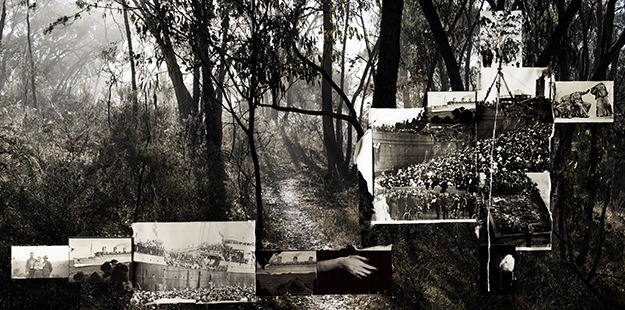 The monumental Morning Star tapestry has been installed at the new Sir John Monash Centre (SJMC) in France in readiness for the official opening on 24 April 2018.
The monumental Morning Star tapestry has been installed at the new Sir John Monash Centre (SJMC) in France in readiness for the official opening on 24 April 2018.
This major tapestry measuring 2.4 x 5m was handwoven at the Australian Tapestry Workshop in South Melbourne and will provide a lasting legacy in perpetuity commemorating the 46,000 Australian lives lost and those who fought in the battles of the Western Front in World War 1 and commemorate the Centenary of ANZAC.
The Morning Star tapestry was designed by prominent Australian artists Lyndell Brown and Charles Green who have been war artists in Iraq and Afghanistan and have had over 30 exhibitions in Australia and internationally.
“It has been an absolute honour to have had the opportunity to weave this important and significant commemorative tapestry for the new Sir John Monash Centre, Villers-Bretonneux, France,” said Antonia Syme, Director Australian Tapestry Workshop. “It is wonderful that this magnificent Australian tapestry will hang in perpetuity in a country with a long and rich history of tapestry weaving,”
Work commenced on the Morning Star tapestry in April 2017 and took the team of ATW weavers Pamela Joyce, Leonie Bessant, Chris Cochius, Jennifer Sharpe, Cheryl Thornton more than 4000 hours to complete. International weavers David Cochrane, Dovecot Studios, Scotland and Pierre Bureau, Manufacture de Beauvais, France travelled to Australia to weave on the tapestry as part of a unique creative and cultural exchange.
The overall image is dawn light during winter illuminating a pathway through eucalypt trees and bush towards sunlight. The inset images are a combination of departures to war by ship from Australia punctuated by visual comments (snaps of these young men, those who were about to enlist).
The Artists have deliberately chosen to make these images almost monochromatic – very tonal with a subtle but definite minimum of colour – since it seems to us, counter-intuitive though that seems, that the weavers at ATW have repeatedly demonstrated enormous, subtle virtuosity in translating very tonal images with precise grey ranges into tapestry.
This tapestry seeks to evoke the experience of arrival at a war, and in particular of Australians at the Western Front,” said Artists, Lyndell Brown and Charles Green. “With them on their arrival were their memories of Australia and their departure from home. These are the subjects of the tapestry.”
“This tapestry aims to evoke the soldiers’ pathway from home to the Front, and emphasizes the incongruity between the Australia that they imagined as they journeyed further and further towards the Front.”
The Sir John Monash Centre will educate a new audience about Australia’s early role in international affairs, reshape patterns of visitation to the Western Front battlefields and in so doing, provide a lasting legacy from the Centenary of Anzac.
The Centre is named after General Sir John Monash, who led the Australian Corps with outstanding success on the Western Front in 1918, including the famous 4 July 1918 victory at Le Hamel which became a template for operations that followed.
Located at the Australian National Memorial near Villers-Bretonneux in France, the Centre will be the central hub of the existing Australian Remembrance Trail along the Western Front, which links First World War sites of significance to Australia, including museums, battlefields, memorials and cemeteries.
For more information about the Sir John Monash Centre, visit: www.sjmc.gov.au For more information about the Australian Tapestry Workshop, visit: www.austapestry.com.au for details.
Image: Lyndell Brown and Charles Green, Morning Star, 2017 (tapestry design)
